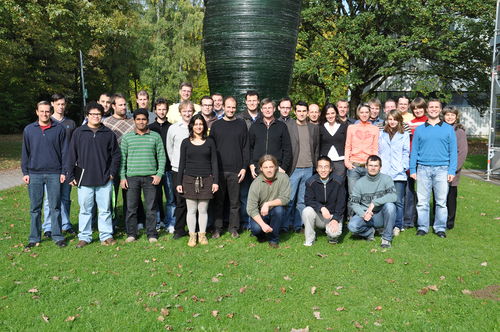Difference between revisions of "Main Page"
(→News) |
(→News) |
||
| Line 9: | Line 9: | ||
== News == | == News == | ||
| + | |||
| + | * '''Dr. Maria Fyta''' von der Universität München hat den Ruf auf die Junior-Professur des SFB 716 angenommen und wird '''ab März 2012''' dem '''Institut für Computerphysik''' angehören. Maria Fyta studierte Physik an der Universität Kreta in Griechenland und promovierte dort 2005 über Energetik und mechanische Eigenschaften von nanostrukturiertem amorphem Kohlenstoff. Ab 2005 war sie wissenschaftliche Mitarbeiterin bei Prof. Efthimios Kaxiras in der Forschungsgruppe Computational Physics and Materials Science in Harvard, USA, wo sie schwerpunktmäßig an biophysikalischen Projekten arbeitete. 2008 wechselte sie zur Technischen Universität München, um im Forscherteam Bio Soft-matter Theory unter Leitung von Prof. Roland Netz die Optimierung von ionischen Kraftfeldern zu untersuchen. Die Einbettung in das Programm des SFB 716 erlaubt Dr. Fyta nun die Kombination ihrer beiden bisherigen Forschungsfelder Festkörperphysik und Biophysik. In ihrer wissenschaftlichen Tätigkeit wird sie sich auf '''multiskalige, atomistische und mesoskopische Simulationen zur Analyse von biomodifizierten Oberflächen und Nanoteilchen, DNA Translokationen durch kleine Poren sowie elastische und optoelektronische Eigenschaften von Kohlenstoff-Materialien''' konzentrieren. Wir heißen die neue Kollegin herzlich willkommen und wünschen ihr einen erfolgreichen Start. | ||
| + | |||
* Our institute's [http://www.icp.uni-stuttgart.de/microct '''world record 3d images'''] of a porous microstructure were highlighted in the December issue of [http://www.pro-physik.de/phy/zeitschriften/oupissue.html Optik & Photonik, vol 6, p. 15 (2011)] and earlier on [http://www.pro-physik.de/details/news/1380843/Weltrekord_in_3D-Bildgebung_eines_Sandsteins.html pro-physik.de]. For [http://www.icp.uni-stuttgart.de/microct more information], [http://link.aps.org/doi/10.1103/PhysRevE.84.062301 publication] and [http://www.icp.uni-stuttgart.de/microct download of our 3d images click here]. | * Our institute's [http://www.icp.uni-stuttgart.de/microct '''world record 3d images'''] of a porous microstructure were highlighted in the December issue of [http://www.pro-physik.de/phy/zeitschriften/oupissue.html Optik & Photonik, vol 6, p. 15 (2011)] and earlier on [http://www.pro-physik.de/details/news/1380843/Weltrekord_in_3D-Bildgebung_eines_Sandsteins.html pro-physik.de]. For [http://www.icp.uni-stuttgart.de/microct more information], [http://link.aps.org/doi/10.1103/PhysRevE.84.062301 publication] and [http://www.icp.uni-stuttgart.de/microct download of our 3d images click here]. | ||
Revision as of 16:19, 28 March 2012

We use high-performance computing on supercomputers and parallel clusters to solve complex problems in physics that would otherwise be impossible to solve via analytical methods. Our main research areas are presently to understand the physics of soft matter systems in general, with a particular emphasis on charged systems like polyelectrolytes, charged colloids, ferrofluids and ionic liquids. In addition we are interested in various biophysical problems, flow phenomena, and porous media. Our methods are not only computer simulations, but we also apply statistical physics approaches like density functional methods, fractional calculus, and other approaches. The simulations are performed on parallel computers with help of the simulation package ESPResSo, and we continue to develop algorithms for long range interactions.
News
- Dr. Maria Fyta von der Universität München hat den Ruf auf die Junior-Professur des SFB 716 angenommen und wird ab März 2012 dem Institut für Computerphysik angehören. Maria Fyta studierte Physik an der Universität Kreta in Griechenland und promovierte dort 2005 über Energetik und mechanische Eigenschaften von nanostrukturiertem amorphem Kohlenstoff. Ab 2005 war sie wissenschaftliche Mitarbeiterin bei Prof. Efthimios Kaxiras in der Forschungsgruppe Computational Physics and Materials Science in Harvard, USA, wo sie schwerpunktmäßig an biophysikalischen Projekten arbeitete. 2008 wechselte sie zur Technischen Universität München, um im Forscherteam Bio Soft-matter Theory unter Leitung von Prof. Roland Netz die Optimierung von ionischen Kraftfeldern zu untersuchen. Die Einbettung in das Programm des SFB 716 erlaubt Dr. Fyta nun die Kombination ihrer beiden bisherigen Forschungsfelder Festkörperphysik und Biophysik. In ihrer wissenschaftlichen Tätigkeit wird sie sich auf multiskalige, atomistische und mesoskopische Simulationen zur Analyse von biomodifizierten Oberflächen und Nanoteilchen, DNA Translokationen durch kleine Poren sowie elastische und optoelektronische Eigenschaften von Kohlenstoff-Materialien konzentrieren. Wir heißen die neue Kollegin herzlich willkommen und wünschen ihr einen erfolgreichen Start.
- Our institute's world record 3d images of a porous microstructure were highlighted in the December issue of Optik & Photonik, vol 6, p. 15 (2011) and earlier on pro-physik.de. For more information, publication and download of our 3d images click here.
- Since Summer 2011, the ICP offers students from German "Gymnasiums" the possiblity to take part in a one-week work experience at our institute (BOGY)
 , where they can learn about computer simulations.
, where they can learn about computer simulations.
- The article "Hydrogels in Poor Solvent - A Molecular Dynamics Study" by Bernward Mann (†2006), Olaf Lenz, Kurt Kremer and Christian Holm is a cover issue of the journal Macromolecular Simulations and Theory.
- Dominic Röhm, member of Axel Arnold's group, is the winner of the NVIDIA Best Program Award, a CUDA competition held at the 20th International Conference on Discrete Simulation of Fluid Dynamics 2011, Fargo, USA . A committee evaluated the submissions and ranked them based on the originality and readability of the code, ease of compiling and running the code, the performance gain compared to a serial CPU version, the quality of the documentation and the scientific content. The lattice Boltzmann GPU code, written during D. Röhm's Diplomarbeit, which is now part of the software ESPResSo, has been awarded with the first place.
Contact
Prof. Dr. Christian Holm (Director)
Rudolf Hilfer JP Dr. Axel Arnold Office:Henriette Patzelt Phone: 49-(0)711/685-6-3593 Fax: 49-(0)711/685-6-3658 |
Institute for Computational Physics
Universität Stuttgart Pfaffenwaldring 27 70569 Stuttgart Germany How to find us? |
Professor Holm's Office Hours: Monday, 13:15 - 14:00
Professor Hilfer Sprechstunde: Donnerstag 13:00 - 13:30 JP Arnold's Office Hours: Monday-Friday, 10:00 - 17:00 |


